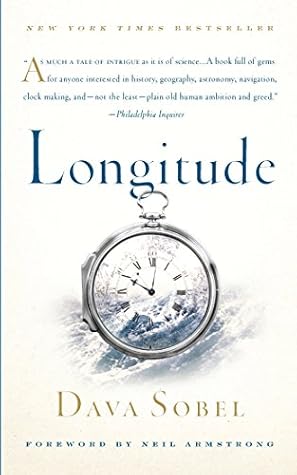More on this book
Community
Kindle Notes & Highlights
by
Dava Sobel
Read between
September 3 - September 12, 2024
The zero-degree parallel of latitude is fixed by the laws of nature, while the zero-degree meridian of longitude shifts like the sands of time.
To learn one’s longitude at sea, one needs to know what time it is aboard ship and also the time at the home port or another place of known longitude—at that very same moment. The two clock times enable the navigator to convert the hour difference into a geographical separation. Since the Earth takes twenty-four hours to complete one full revolution of three hundred sixty degrees, one hour marks one twenty-fourth of a spin, or fifteen degrees.
Every day at sea, when the navigator resets his ship’s clock to local noon when the sun reaches its highest point in the sky, and then consults the home-port clock, every hour’s discrepancy between them translates into another fifteen degrees of longitude.
One degree of longitude equals four minutes of time the world over, but in terms of distance, one degree shrinks from sixty-eight miles at the Equator to virtually nothing at the poles.
In the course of their struggle to find longitude, scientists struck upon other discoveries that changed their view of the universe. These include the first accurate determinations of the weight of the Earth, the distance to the stars, and the speed of light.
English clockmaker John Harrison, a mechanical genius who pioneered the science of portable precision timekeeping, devoted his life to this quest. He accomplished what Newton had feared was impossible: He invented a clock that would carry the true time from the home port, like an eternal flame, to any remote corner of the world.
The moon travels a distance roughly equal to its own width every hour.
Indeed, King Louis XIV of France, confronted with a revised map of his domain based on accurate longitude measurements, reportedly complained that he was losing more territory to his astronomers than to his enemies.
Roemer used the departures from predicted eclipse times to measure the speed of light for the first time in 1676. (He slightly underestimated the accepted modern value of 300,000 kilometers per second.)
(Multiplying a difference in hours by fifteen degrees gives only an approximation of location; one also needs to divide the number of minutes and seconds by four, to convert the time readings to degrees and minutes of arc.)
Not only did H-2 survive this drubbing but it won full backing from the Society: “And the Result of these Experiments, is this; that (as far as can be determined without making a voyage to sea) the motion is sufficiently regular and exact, for finding the Longitude of a Ship within the nearest Limits proposed by Parliament and probably much nearer.” But it wasn’t good enough for Harrison.
With his marine clocks, John Harrison tested the waters of space-time. He succeeded, against all odds, in using the fourth—temporal—dimension to link points on the three-dimensional globe. He wrested the world’s whereabouts from the stars, and locked the secret in a pocket watch.


